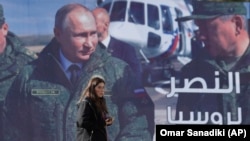On March 28, Sputnik News in Arabic, a state-owned Russian news agency, said that a group of Islamic jihadists had left Syria to fight against Russian forces in Ukraine. Citing “private sources,” Sputnik said 87 militants went to Ukraine, all of them former members in the Islamic State (IS) terror group.
Sputnik said most of the militants are from Iraq, Chechnya, Tunisia and France. After leaving IS, they had linked up with other jihadist groups in northwestern Syria, including Hay'at Tahrir al-Sham (HTS) and al-Qaida affiliates Hurras al-Din (HaD) and Ansar al-Tawhid.
“Private sources confirmed to Sputnik that 87 militants had left for Ukraine … all of the 87 used to be affiliated with Daesh [Islamic State] before they merged into new groups,” Sputnik reported.
This is unsubstantiated.
Sputnik provided no evidence for its claim. Moreover, in earlier reports, Sputnik provided contradictory numbers of the purported militant fighters. Sputnik has also claimed without evidence that the United States is training jihadists in Syria to send them to Ukraine.
Russia and its ally Syria have been trying to exploit jihadist propaganda since President Vladimir Putin ordered his “special military operation”, a.k.a. war, against Ukraine on February 24.
On February 28, Al Baath media, a state-owned Syrian news network, said mercenaries from Nusra Front and other factions would be heading to Ukraine to fight the Russians.
“The Central Intelligence Agency (CIA) asked Turkish intelligence to train militants and send them from Syria to fight in Ukraine,” Al Baath claimed, citing unnamed media reports and Israel’s Yedioth Ahronoth newspaper.
On March 8, Iran’s Tasnim news agency cited a Sputnik report that hundreds of terrorists from various armed groups had arrived in Ukraine. The agency cited unnamed sources as saying the United States is training IS terrorists at its al-Tanf base in eastern Syria who will then be transferred to Ukraine.
The U.S. has maintained an army garrison in al-Tanf, along Syria’s border with Iraq, since 2016, to counter IS operations.
Sputnik has been inconsistent in its reporting on the number of “terrorists” allegedly fighting in Ukraine. On March 3, it reported that the Ukrainian government had granted asylum to more than 1,000 terrorists, including jihadists from Syria.
“In the current situation, the goal of the special military operation in Ukraine is not just eliminating Nazism, but also combating terrorism,” Sputnik quoted an anonymous source as saying.
On March 4, Syrians for Truth and Justice (STJ), a human rights watchdog, reported on an ongoing process to register the names of experienced combatants in Syria to fight in Ukraine. The registration drive was initiated by some fighters and commanders within the rebel groups, the group said.
STJ said that in rebel-controlled areas of Syria, mainly those under the influence of the Turkish army, some armed factions had indeed asked their leaders to register.
However, a first-class officer in the Syrian National Army (SNA), a coalition of armed groups opposed to the regime of Syrian leader Bashar Assad, told STJ that Syrian rebels brought up deployment to Ukraine to Turkish intelligence.
“These registrations have been initiated based on the factions’ desire to fight the Russians, and this has been explicitly expressed during a meeting between the Turkish intelligence service and second-class commanders,” STJ quoted the first-class officer as saying.
“The commanders asked for permission to travel and fight in Ukraine. However, the Turks were clear that they will not send experts from the Turkish army to fight in Ukraine and that Turkey is keeping equal distance from the Ukrainians and the Russians.”
Assad’s government controls most of Syria, while the Kurdish-led Syrian Democratic Forces control the northeastern part. The Turkish-backed SNA controls northern Syria, while disparate factions operate in the northwest, dominated by HTS. Scattered IS cells also operate in the Syrian desert.
Russia has provided the Assad regime with extensive military support and defended it against accusations of using chemical weapons during Syria’s decade-long civil war.
While Sputnik raised alarms about Syrian fighters going to Ukraine to fight against Russia, the Kremlin has opened the door for Syrian mercenaries to join the Russian side. On March 11, the Putin green-lighted the recruitment of 16,000 volunteers from the Middle East.
"If you see that there are these people who want of their own accord, not for money, to come to help the people living in Donbas, then we need to give them what they want and help them get to the conflict zone," Putin said.
STJ said it interviewed two people in Syrian government-controlled areas who were attracted to Putin’s appeal.
One was a young soldier who registered his name mainly for economic reasons, while the other was a member of a government reconciliation committee in the Rif Dimashq governorate (Damascus countryside).
“The process is still in its early stages, the stage of registration,” the latter told STJ. “Russians will decide whether to send those who registered or not after they have been trained by Russian officers for a while.”
On March 29, Syria’s Deir Ezzour 24 news website reported that Abdullah Shlash, the head of the reconciliation committee in Deir el-Zor, announced that hundreds had signed up to join Russian forces in Ukraine and were waiting for further instructions from the Russian and Syrian authorities.
Still, there is no evidence that anyone has left to fight for either side in Ukraine, the Syrian Observatory for Human Rights, a U.K. human rights monitor, reported.
On March 18, Gen. General Kenneth F. McKenzie, commander of the United States Central Command, told reporters: “We see little evidence of recruiting in Syria to bring people back to Ukraine.”
Turkey is mediating peace talks between Moscow and Kyiv. On March 29, delegations from Ukraine and Russia concluded a round of negotiations held in the capital Istanbul. Both sides expressed optimism about a possible peace deal, but no major breakthrough was reached as the attack on Ukraine enters its second month.





